The economy of a growing country relies heavily on the supply and demand chain. Demand depends on the willingness and ability of the consumers to buy a product or service. Demand drives the producers and manufacturers to increase supply and thus the economy thrives.
Demand is created by consumers. There are different types of demands that exist. Composite Demand is one such type of demand which occurs when a product or item has multiple uses.
In this article, we focus on Composite Demand.
The composite demand function shows the relationship between the price of a product and the total quantity demanded by all the consumers in the market. It is obtained by horizontally summing up the individual demand curves of all the consumers.
The composite demand curve is important as it helps firms determine the total market demand for a product. By knowing the composite demand curve, a firm can estimate the maximum amount it can sell at different price levels in the market. This helps in production planning and sales forecasting
What is composite demand?
Composite demand is a common type of demand that occurs when a product finds multiple uses. Composite demand refers to the total demand for a product from all the consumers in a market. It is the sum of the individual demand curves of all the consumers.
Demand for milk, sugar, steel, petrol, and coal creates composite demand because these products produce many other items like cheese, butter and sweets from milk, plants and machinery, cars, and bicycles from steel.
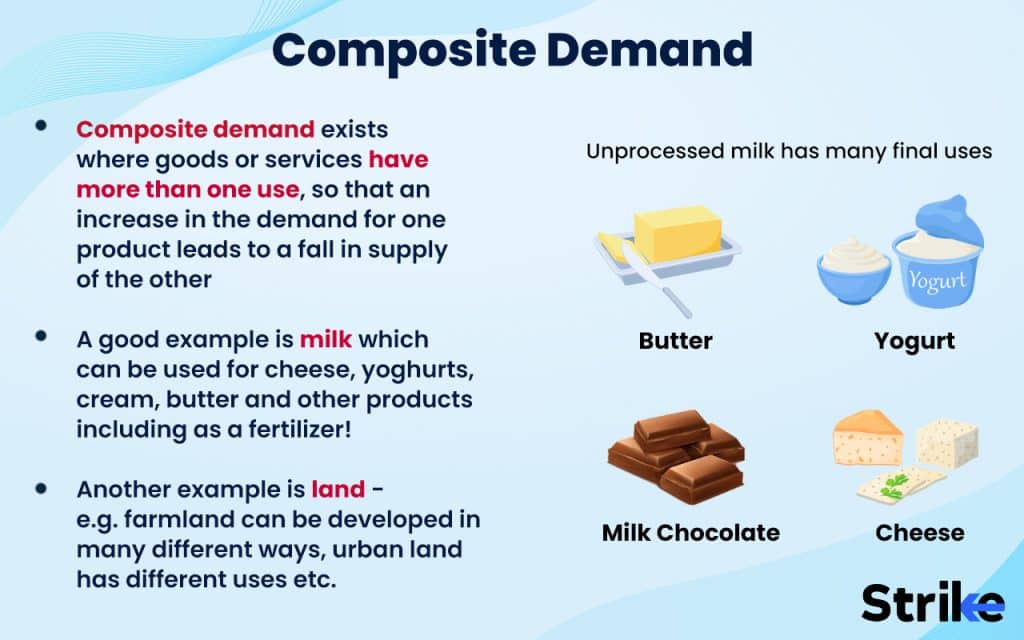
Let us take the example of milk. Milk is a dairy product. Milk is produced in limited quantities. We cannot produce as much milk as we want.
We drink milk in raw forms. We also produce butter, cheese, yogurt, curd, milk powder, baby food, milk chocolate, cream and sweets from milk.
Demand for one of these items increases leading to a shortage in the supply of milk for other products.
Demand for milk chocolate increases during the winter seasons. Manufacturers produce more milk chocolates to meet consumer demand. This phenomenon causes a shortage of milk supply to manufacture other products. This shortage of supply of milk increases the price of other products manufactured from milk.
What is the importance of composite demand?
Composite demand shows us the relationship between consumer products and how the demand for one affects the price of others.
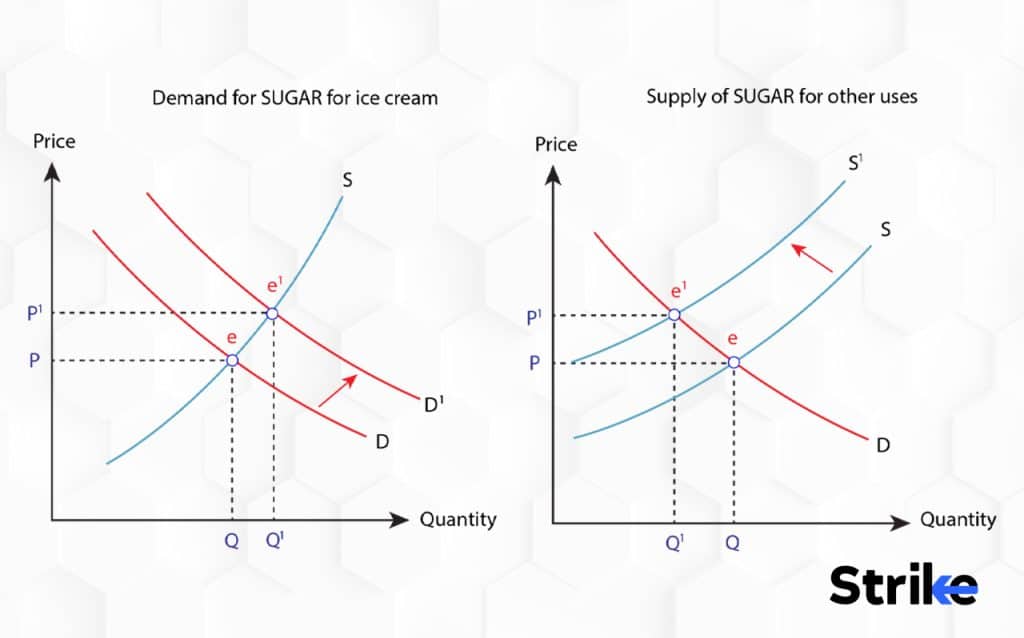
Sugar is used to manufacture many other products as well such as ethanol for industrial fuel and sweetener for food products.
The graph above shows the high demand for sugar during the summer season because there is high demand for ice cream. This phenomenon causes a shortage of sugar for other products which are manufactured using sugar as raw material. A short supply of raw materials leads to a rise in the price of these products. Thus composite demand causes prices to rise and fall for different products.
Today, the market is not limited to one country. One raw material is used in many other countries. We see the use of fuel, sugar, wheat, wood and many other items imported by many countries for the manufacture of many items.
Brazil uses sugar to produce ethanol. Ethanol is used as fuel for cars in Brazil. Brazil imports sugar in raw form from India. When there is a hike in diesel prices, Brazil places more demand for sugar imports from India.
When GOI allows higher export of sugar to induce more foreign currency into the system, the price of domestic sugar increases. Government creates a delicate balance but during times of high demand for sugar from Brazil, we pay higher prices for domestic sugar.
That is why it is important to know the composite demand and how it affects the market and the overall economy.
Composite demand is important because it also incorporates the demand of all consumers. The composite demand takes into account the demand from all segments of consumers in the market – both individuals as well as institutions. It provides a holistic view of the total potential market size for a product. Just looking at the demand from a few major consumers provide an incomplete picture. The composite demand overcomes this limitation.
For example, the demand for a product comes from high-income individuals, middle-income households, students, companies, schools, hospitals, etc. The composite demand includes the demand from all these consumer groups and hence presents the aggregate picture. It is useful for planning production capacities.
Firms utilize the information from the composite demand curve to efficiently plan their production facilities and capacities. Analyzing the current as well as projected future composite demand helps firms determine how much to produce to meet the demand, when to expand capacity, and when new facilities are needed.
What is the function of composite demand?
Composite demand causes a rise in demand for one product that leads to a shortage in supply for others. A short supply of raw materials causes a rise in the price of products that use the same raw material. The demand for one product affects the price of all related products in the case of composite demand. This is utilized in the ways described below.
A phone has a composite demand. People wanting to use phones primarily use the phone for communication. A market research company visits phone users and studies their patterns and demand for phone use.
Today a person does not want to buy a costly DSLR. Instead, the person wants to buy a phone that comes with a good-quality camera. A young person wants to buy a phone that gives the highest internet speed and good capacity RAM for video creation and related uses.
The market research company finds this data, analyzes input from consumers and helps the phone manufacturing company to come up with a model that steals the show. It is one way how the composite demand data functions in business. Multiple uses of one product increase the sale of products that fulfil multiple demands through one product.
But this also has a downside. The product reduces the demand for other products. The DSLR camera market is affected by phones. Composite demand affects many such products. Business communities and authorities manipulate these effects to their advantage. We see similar effects in cases of steel, wood, coal, crude oil and many other products that have limited resources.
How does composite demand work?
Composite demand refers to the total demand for a group of related goods or services. It arises when two or more goods are so closely related that they are substitutes or complements for one another. The demand for one product depends on the demand for the other, and vice versa. For substitutes, like Coke and Pepsi, the demand for one goes up when the price of the other goes up. Consumers switch between the two options based on relative prices. Coke raising its price, for example, means some consumers will switch to Pepsi, increasing its demand. For two substitute goods, their composite demand curve will be more elastic or price-sensitive. Even if the price of one goes up, the total demand will not change much as consumers shift to the other option.
For complements, like computers and software, the demand for one goes down when the price of the other goes up. The price of software increases, for example, means the demand for computers will decrease because the overall package has become less affordable or valuable. For complementary goods, their composite demand curve will be more inelastic or price-insensitive. The total demand will go down significantly as the bundle is less desired when the price of one complement goes up.
The composite demand curve for a group of related goods is derived by summing up the individual demand curves for the components. Its position and elasticity depend on the nature of the relationship between the goods – whether they are substitutes, complements or unrelated. The elasticity of composite demand provides insight into consumer response to price changes and the degree of substitutability or complementarity between the products. Firms use this information to better set pricing strategies for their portfolio of goods.
Composite demand works only when there are multiple demands for a single product. For example, corn is needed to produce ethanol, food and food products, animal feed and biodegradable bags in retail shops. When there is a sudden increase in demand for ethanol, the higher demand leads to a shortage in the supply of corn for other products. The short supply causes a rise in the price of other products.
What is a good composite demand?
A good composite demand refers to a situation where a specific good or resource is demanded for multiple uses or purposes. The demand for such good comes from various sources, as it serves different functions in the economy. This leads to competition among consumers and may impact price, supply, and allocation of the resource. For example, consider crude oil. It is good with high composite demand because it is used as a raw material for producing various petroleum products such as gasoline, diesel, jet fuel, plastics, and chemicals. The demand for crude oil comes from various industries, transportation sectors, and households. This diverse demand leads to fluctuations in the price and availability of crude oil depending on various factors such as geopolitical events, production capacities, and alternative energy sources.
In the case of goods with high composite demand, efficient allocation and management of the resource become crucial to ensure that all the different sectors can access the required supply without significant negative impacts on the economy or the environment.
What are the factors that affect composite demand?
There are five basic factors that affect composite demand material cost, availability of substitutes, consumers’ demand and others shown below.
Material cost
Material cost plays a significant role in determining composite demand. When the cost of a particular material used in the production process increases, it impacts the overall demand for the final product. For example, Te price of steel rising significantly will cause consumers to seek alternative alloys or materials that are more cost-effective. This shift in demand affects the entire industry, as manufacturers may need to adjust their production processes or find substitutes for the expensive material.
Distance from source to the manufacturer
The distance between the source of raw materials and the manufacturing facility influence composite demand. The source of a particular raw material becomes depleted or inaccessible if they are not closer, AND manufacturers need to import the material from distant locations. This results in increased transportation costs, longer lead times, and potential supply disruptions. Consequently, these factors impact the overall supply, demand, and pricing dynamics of the products.
Consumers’ demand
Composite demand is influenced by consumer demand for a particular product. The demand for one product increasing will drive the demand for related products, creating a composite demand. For instance, a surge in demand for smartphones will lead to increased demand for complementary products such as phone cases, screen protectors, and charging cables. The interdependency between products in meeting consumer needs contributes to composite demand.
Consumer taste and preferences
Consumer taste and preferences play a crucial role in shaping composite demand. Consumers consistently prefer certain features, designs, or brands, it influences the demand for related products. For example,Consumers developing a preference for eco-friendly products will drive demand for environmentally sustainable materials, packaging, and production practices across multiple industries. Manufacturers need to align their offerings with changing consumer preferences to maintain demand for their products within the composite demand framework.
Availability of substitutes
The availability of suitable substitutes affects composite demand. The price of a product rising will make customers seek alternative products or solutions that offer similar benefits at a lower cost. The presence of substitutes impacts the demand for a specific product and, consequently, the entire composite demand. For instance, The price of a certain brand of coffee increases significantly will cause consumers to switch to other brands or types of beverages as substitutes, thereby affecting the composite demand for coffee and related products.
Composite demand is primarily driven by these factors. Besides the above factors, the demand may rise due to global emergencies like Covid 19 and unseen such factors. These factors directly affect consumer demands.
What is an example of composite demand?
The composite demand example is explained with the help of a graph shown below.
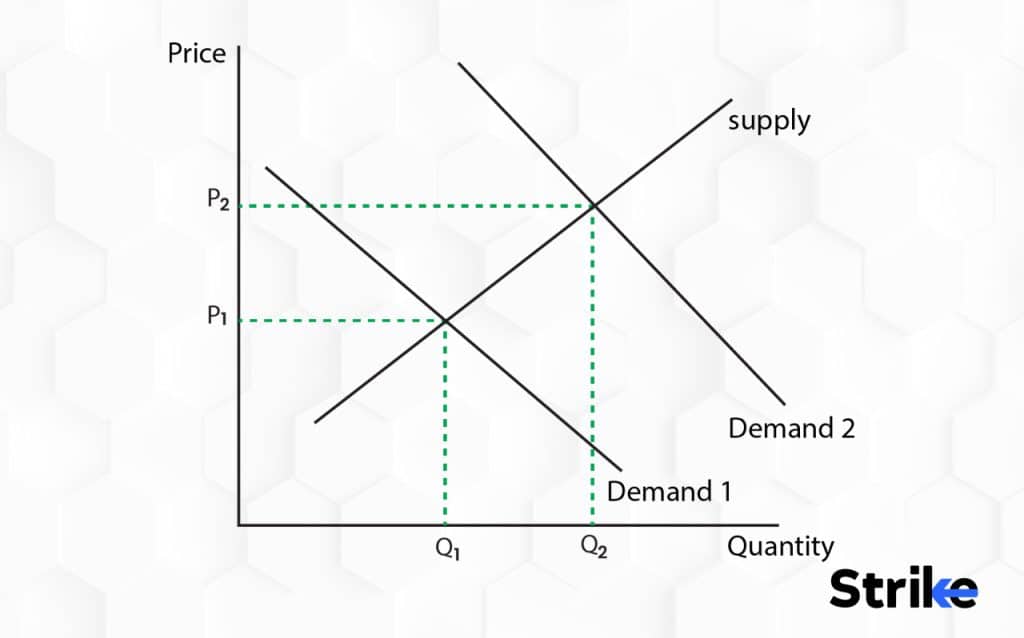
In the graph above, the x-axis represents the demand and the y-axis represents the price. P1 and P2 are ower ad higher prices respectively. Q1 and Q2 are lower and higher demands.
P2>P1 and Q2>Q1
The Demand1line is drawn on the intersection point of P1Q1 and the Demand 2 line through P2Q2. The Supply line is drawn through P1Q1 and P2Q2 intersecting the Demand 1 and Demand 2 lines.
This is a classical representation of the price of the demand for milk and how the demand is impacted due to other milk products.
The increase in demand from Demand 1 to Demand 2 may happen due to an increase in one or all milk products. This increase may happen due to an increase in demand for sweets and creams during festive seasons.
The increase in demand for cream and sweets leads the manufacturer to use more milk or production of these products in larger quantities. These higher usages of milk create a fall in the supply of milk for other dairy products.
Higher demand creates a rise in prices as seen in the graph. The price moves from P1 to P2. In the graph, the zone between the Demand 1 and Demand 2 lines shows the higher demand zone where the price moves from P1 to P2.
The higher demand for one dairy component increases the price of all dairy products including raw milk.
So, we see the demand for sweets etc can increase the price of all dairy components including raw milk. This is a perfect example of how the composite demand works practically and influences the prices of a large array of products.
What is the formula for composite demand?
Composite demand is calculated by summing the demands for the individual components.
The formula for composite demand is: Composite Demand = D1 + D2 + D3 + … + Dn
Where:
D1, D2, D3, …, Dn represent the demands for each of the n goods or services in the composite group.
For example, the composite demand for the breakfast market might include:
•D1 = Demand for bread
•D2 = Demand for eggs
•D3 = Demand for bacon
•D4 = Demand for orange juice
•D5 = Demand for cereal
The composite demand would be the total of D1 + D2 + D3 + D4 + D5 + …
Factors like prices, consumer incomes, tastes and preferences will affect the demand for each individual component (D1, D2…). And in turn, changes in these individual demands will shift the overall composite demand curve. The composite demand approach is useful to analyze how the total demand for a group of interdependent products may be impacted by various economic factors. The closeness of the relationship between the goods, availability of substitutes, and other factors determine how much a change in one product’s demand will affect the composite demand.
How to calculate composite demand?
The calculation of composite demand uses a summation of all demands of all products produced from that specific product. Steel is used to manufacture many industrial and consumer products. The composite demand for steel is calculated by adding up all the demands of all steel products.
Step one in calculating composite demand involves identifying related goods or services. This could mean finding products with similar raw material inputs, customer needs or interdependencies, such as cereals, cars and aircraft or tourism services. Step two involves estimating demand for each component within this grouping. This depends on factors like prices, incomes, tastes seasonality availability of alternatives (for instance units sold, revenue generated or passenger numbers) etc. Step three involves measuring this demand using units sold, revenue generated or another measurable metric like tons sold revenue or passenger numbers etc.
Calculate the total composite demand by adding all of the requirements for all individual components using this formula: Composite Demand = D1 + D2 + D3 +… +Dn
Where D1, D2,…, Dn is the demand for each of n goods or services.
Next, examine how factors that impact individual demands have an effect on composite demand. For instance, how would price changes for key input materials influence demands and composite demand overall? How does economic expansion or contraction alter it? Project future trends that alter the composite demand curve. Be mindful of factors like changing consumer tastes, new technologies, availability of substitutes and external events. As more products interact closely, their demands will become interdependent. Use composite demand analysis to identify opportunities and risks facing related industries. Explore factors that could increase or decrease total demand for the product group; this can inform business strategies and policy decisions. Recalculate composite demand regularly according to changes in individual component demand – then adapt your analysis as economies and markets change over time.
Below is an example of the calculation part. Let’s analyze the composite demand for various wheat-based products.
*D1 = Demand for whole wheat flour or atta: 15 million tons D2 = Bread Consumption in North India: 25 Million Tons D3 = Demand for Biscuits in North India (10 Million Tons).
D4 = Vermicelli/ Sevian Production in North India – 5 Million Tons whilst *D5 = Pasta demand is three Million tons.
Indian wheat products would experience high demand. Imagine wheat prices increasing due to lower crop yields; this would likely affect demand as follows:
*D1 = Demand for Atta decreases to 13 million tons (down 2 million tons). D2 = Bread Demand decreases to 22 Million Tons (3 Million tons fewer), whilst biscuit demand has seen an additional decrease (to 9 Million tons, down one million tons). Nevertheless, D4 and D5 remain unaffected.
The new composite demand would consist of: Composite Demand = D1+2+D3 + D4 + D5 => 13 + 22 + 9 + 5 + 3
So in this example, an increase in wheat prices caused a reduction of 6 million tons in composite demand for wheat products (from 58 million tons to 52 million tons). Wheat-intensive products, like atta and bread, were particularly affected; but overall demand declined less significantly for products where wheat plays less of an input like biscuits; it even held steady among small-scale uses like vermicelli and pasta – demonstrating how price fluctuations for key ingredients like wheat can alter food products that depend on it depending on its relative importance; using composite demand allows an overview of total impact across this related group of food products.
What does a higher composite demand mean?
A higher composite demand occurs when the demand for one product increases the demand for other products as well. The price of crude oil surges to $100 per barrel, and the prices of all goods increase because diesel prices increased. Diesel is used by all public and private carriers to carry goods. The increase in carrying cost increased the cost of all goods.
A higher composite demand means that the total demand for a group of related goods or services has increased. This is usually a positive sign for the industries producing those products. Increased sales and revenue is a direct implication of higher composite demand. The demand rises for the product group as a whole, and sales and revenue of the individual components also increase. This drives business growth. Greater production is also possible to meet the higher demand. Manufacturers need to produce more here. This requires expanding operations, hiring more workers, and increasing output.
Composite demand is strong relative to supply means it gives producers more ability to raise prices. This also contributes to increased revenue and profitability. A rise in composite demand signals an opportunity for producers to gain market share and increase sales. This spur investments in new technologies, product improvements, marketing, and other areas.
A boost in composite demand for one product group can also benefit related industries up and down the supply chain. For example, higher demand for vehicles benefits parts suppliers, raw material producers, and fuel providers. Gains in composite demand for a major product group or sector lead to overall economic expansion. Increased production, job creation, spending, and investments all drive GDP growth.
However, a higher composite demand also presents challenges. It will be difficult for producers to keep up with rapid increases in demand, especially in the short run. Key inputs like labor, materials or production capacity could be limited. Strong demand creates the opportunity to raise prices, but it also stimulates competition.
Rivals cut prices to try and capture extra market share. Profit margins could suffer as a result. Demand growth is concentrated in a speculative bubble causing risks of eventually crashing down. What goes up quickly comes down just as fast. Industries must manage growth in a sustainable way. A surge in demand that significantly outstrips supply can lead to higher inflation in the overall economy. Policymakers need to tighten the money supply to stabilize prices.
Higher composite demand is typically a positive sign for related industries and the economy, indicating opportunities for growth. However, it also brings risks around supply constraints, pricing pressures, boom-bust cycles and inflation. Firms must respond to demand growth in a strategic and sustainable manner.
What does a lower composite demand mean?
Lower composite demand means a decrease in demand for all goods related to composite demand. The price of all related products decreases due to a sudden increase in the availability of steel, If the demand for steel decreases due to a lack of global demand for steel. This situation creates a lower composite demand.
Lower composite demand means that the total demand for a group of related goods or services has decreased. This usually has negative implications for the industries producing those products. The main effect of a lower composite demand include is declining sales and revenue. As demand drops for the product group as a whole, sales and revenue of the individual components also decrease. This hurts business performance and profitability. To align with the lower demand, manufacturers need to cut back on output. This requires downsizing operations, laying off workers, and decreasing production and inventory levels. Composite demand weakens also reduces the ability of producers to raise or maintain prices. They have to lower prices to spur additional demand. Profit margins typically narrow as a result. A fall in composite demand signals a more challenging market environment with limited opportunities for revenue growth. Investments in new products, technologies, marketing etc. are scaled back. decrease in composite demand for one product group can also hurt related industries up and down the supply chain. For example, lower vehicle demand impacts parts suppliers, raw material producers, and fuel providers. Declines in composite demand for a major product group or sector lead to an overall slowing economy. Reduced production, job losses, decreased spending, and limited investments all weigh on GDP growth.
Strategies to address a lower composite demand include focusing on operational efficiency. Trim costs and improve productivity to sustain profitability despite demand weakness. Optimize processes and make structural changes. Introduce lower-cost product options, bundles and promotions to attract more price-conscious customers. Gain market share. Develop new or improved products to boost demand. Stay ahead of trends and preferences to meet evolving customer needs. Expand into underserved geographic areas or customer segments. Diversifying demand helps reduce reliance on any one market. Cut excess capacity to lower costs in line with demand. Only invest to meet actual needs. Remain flexible to respond if demand starts recovering. Companies also work with suppliers, distributors or other partners to share resources and operate more efficiently. Collaboration helps in a challenging market environment.
How does composite demand affect the economy?
A rise in demand and price of a single commodity does not have a large effect on the economy. But the composite demand creates demand for a big number of goods. A rise and fall in demand for a large number of goods affects a large number of people and that has a telling effect on the economy.
Wheat is used as food grain, to manufacture biofuel, to manufacture bread and for feed for domestic animals. The price of all related goods increases if the supply of wheat is reduced. The recent Russia-Ukraine war has badly affected the global supply of wheat. Ukraine was the primary supplier of wheat to Africa, America and Europe. The drop in supply has increased the price of wheat and all other related products across the world. This has a telling effect on the world economy at large.
Composite demand rising for a sector or the economy as a whole leads to economic expansion. But a fall in demand causes contraction. A rise in composite demand increases production and sales, which boosts GDP. Growth in demand for key sectors like automobiles, housing or energy can substantially accelerate GDP growth. Higher demand also encourages companies to hire more workers to meet increasing production needs. The job market benefits as a result. Greater composite demand spurs investments in new equipment, technologies and facilities to increase output and gain market share.
But lower demand leads companies to limit investments due to uncertainty and reduced opportunities. An increase in demand, especially for large sectors, also generates higher income for those employed directly and indirectly in related industries. More spending power then fuels even greater demand. Changes in demand for one industry spill over onto upstream and downstream partners, as well as local communities.
For example, stronger auto demand benefits steel producers, parts suppliers, dealerships, and nearby businesses. Declining demand reversely impacts related groups. A sharp rise in demand that far outpaces supply capabilities leads to higher inflation. Increased demand bids up prices. Demand-pull inflation requires policy response. Falling demand, on the other hand, puts downward pressure on prices. Strong domestic demand attracts foreign trade and investment, as partners seek to benefit from growth.
But weak demand deters global trade and capital flows in favor of more robust markets. Exports and imports depend partly on demand conditions. Growth in demand for an industry’s output boosts the value of related company stocks and the overall stock market. Declining demand lowers stock values, which negatively impacts consumer wealth and confidence.
How does composite demand affect the stock market?
The composite demand affects the stock market because composite demand affects the price of some commodities. We can take the instance of the rise and fall of crude oil.
It was not long, during the time of the Covid crisis, the international crude price reached the bottom of negative price range, which was unprecedented. The price of all commodities fell with it as there was no demand. The stock market fell to a record low.
Today, within a little more than two years, the stock market soared to a new high. Because the demand for all commodities, especially the price of metals rose. The demand for commodities is a driving factor of the stock market. Commodities mostly have composite demands. Steel, iron, copper, aluminium, silver, gold, food grains and oil – all have multiple uses and create composite demand.
Composite demand increase for a group of commodities and related products increases the overall prices and helps to push the price of different stocks to create higher highs. This phenomenon in turn brings bull into the market and the stock market starts a bull run. Contrarily when the demand for commodities comes down, a bear trend in the stock market starts. Low composite demand adds fuel to new downtrends.
How does composite demand affect consumers?
Composite demand directly affects consumers. The demand for one product rising leads the supply of raw materials reducing for other related products. The production of other products gets hampered due to a lack of supply of raw materials. This phenomenon increases demand for other products and the demand-supply gap helps to increase the price of all commodities in the group. The price of raw materials also increases due to this effect.
Consumers have greater choices and availability of goods as companies increase production to meet growing demand. They will be able to more easily find and purchase what they need. Higher demand also incentivizes businesses to invest in new or improved products to best serve customers and gain market share. So consumers gain access to the latest options that suit their needs. Strong demand creates jobs as companies expand to handle increased production. This decreases unemployment and raises household income levels.
Consumers then have greater spending power to make purchases according to their wants. Higher demand also commonly leads businesses to offer discounts, promotions and lower prices to drive sales. Consumers can take advantage of more attractive deals and their dollars go further. A sharp rise in demand can lead to inflation if supply struggles to keep up. The increased competition for goods and services bids up prices. This benefits producers, but consumers end up paying higher costs for products. Inflation decreases purchasing power and living standards unless income growth outpaces price increases.
As companies cut back production in response to weakening demand, consumer choice and availability of certain goods decrease. It becomes harder to find and buy what is needed. Businesses also curb investments in product improvements and innovation during demand downturns. So consumers lack access to the latest options. Falling demand leads companies to reduce hiring or lay off workers to lower costs. Higher unemployment and drop in household income negatively impact consumer spending ability. Budgets tighten, and people can only afford essential purchases.
Companies may lower prices to try to boost demand, but consumers remain limited by their reduced income. Deflation, or decreasing price levels, seems beneficial to consumers at first glance. However, declining demand is often accompanied by a broader economic slowdown with job losses, limited wage growth and decreasing wealth. So while goods become more affordable, consumers earn and owe less. Their financial situations still deteriorate overall during deflationary periods of weak demand.
What is the difference between composite demand and competitive demand?
In competitive demand, when one product purchased increases, it causes the demand for other products to reduce. For an example of competitive demand, two products are in composite demand. One product is preferred by the consumers, the demand for the other product reduces, If two products are market competitors,
Here in the graphical representation, the demand for Brand A printing paper reduces the demand for Brand B printer paper because the Brand is a close substitute for Brand A.
The impact of demand between two competitor brands here is understood through the cross-elasticity of demand. The fall in the price of one product leads to a fall in demand for another brand if the cross-elasticity of demand is positive. Because consumers move towards the cheaper option.
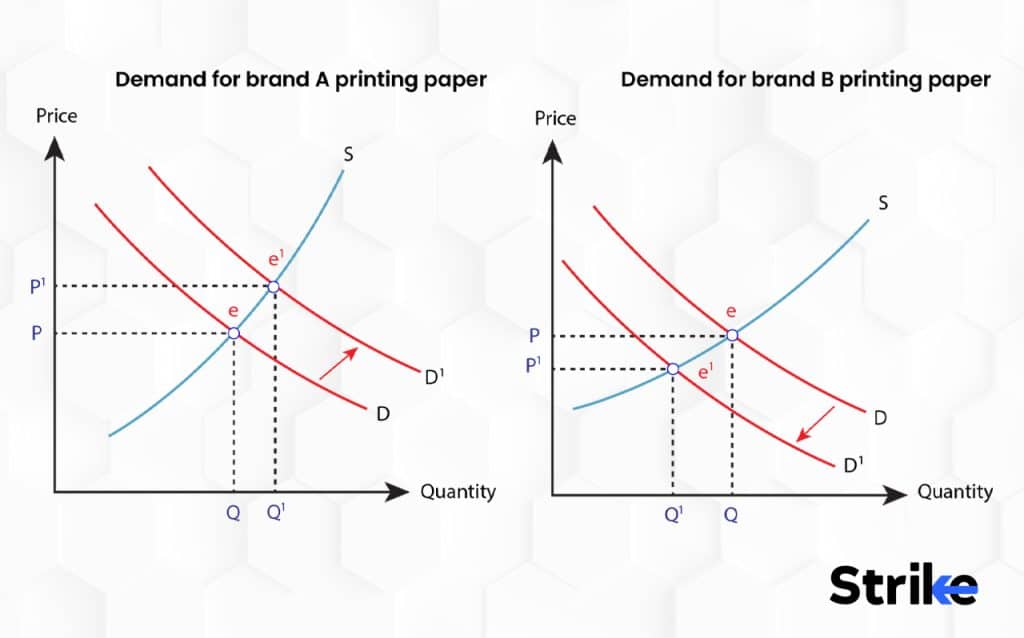
Composite demand occurs when one product has multiple uses. In composite demand, a rise in demand for one product leads to a rise in the price of all related products.
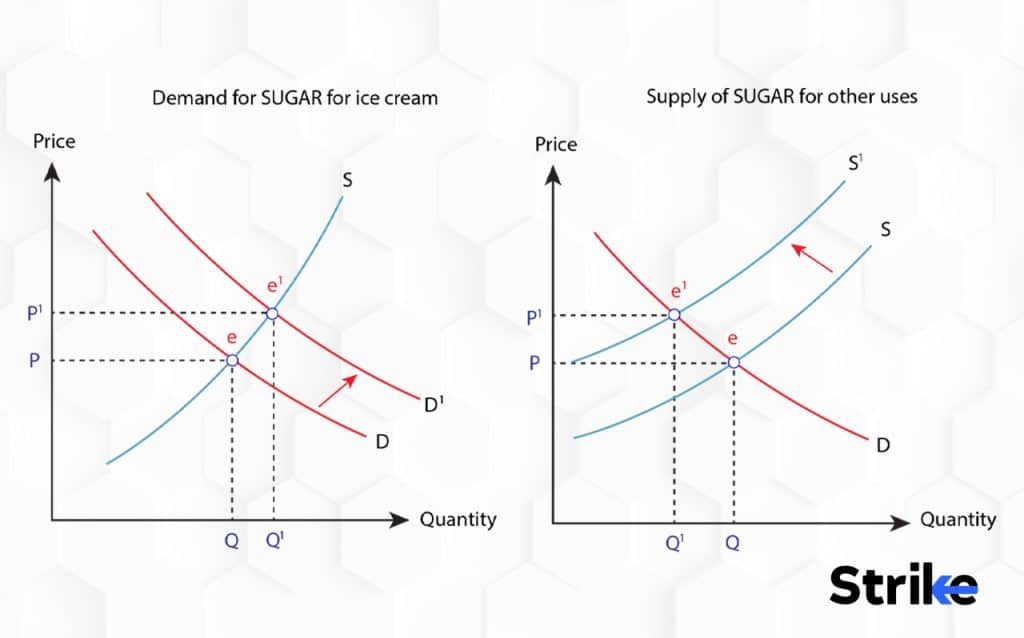
When the demand for sugar increases due to the high demand for ice cream, the supply of sugar reduces for all products that use sugar for production. This phenomenon increases the price of all other products that require sugar for production.
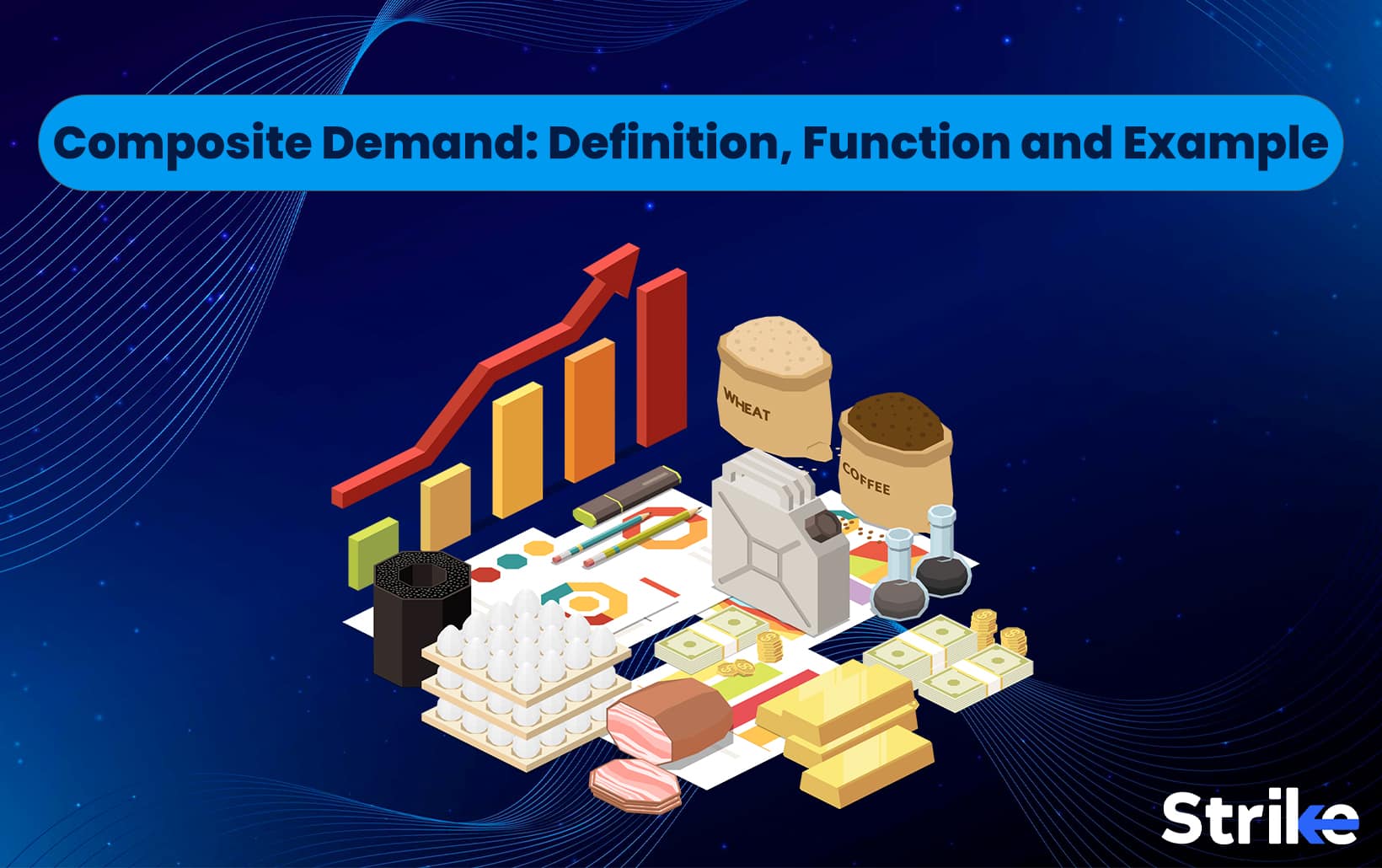





 Previous Article
Previous Article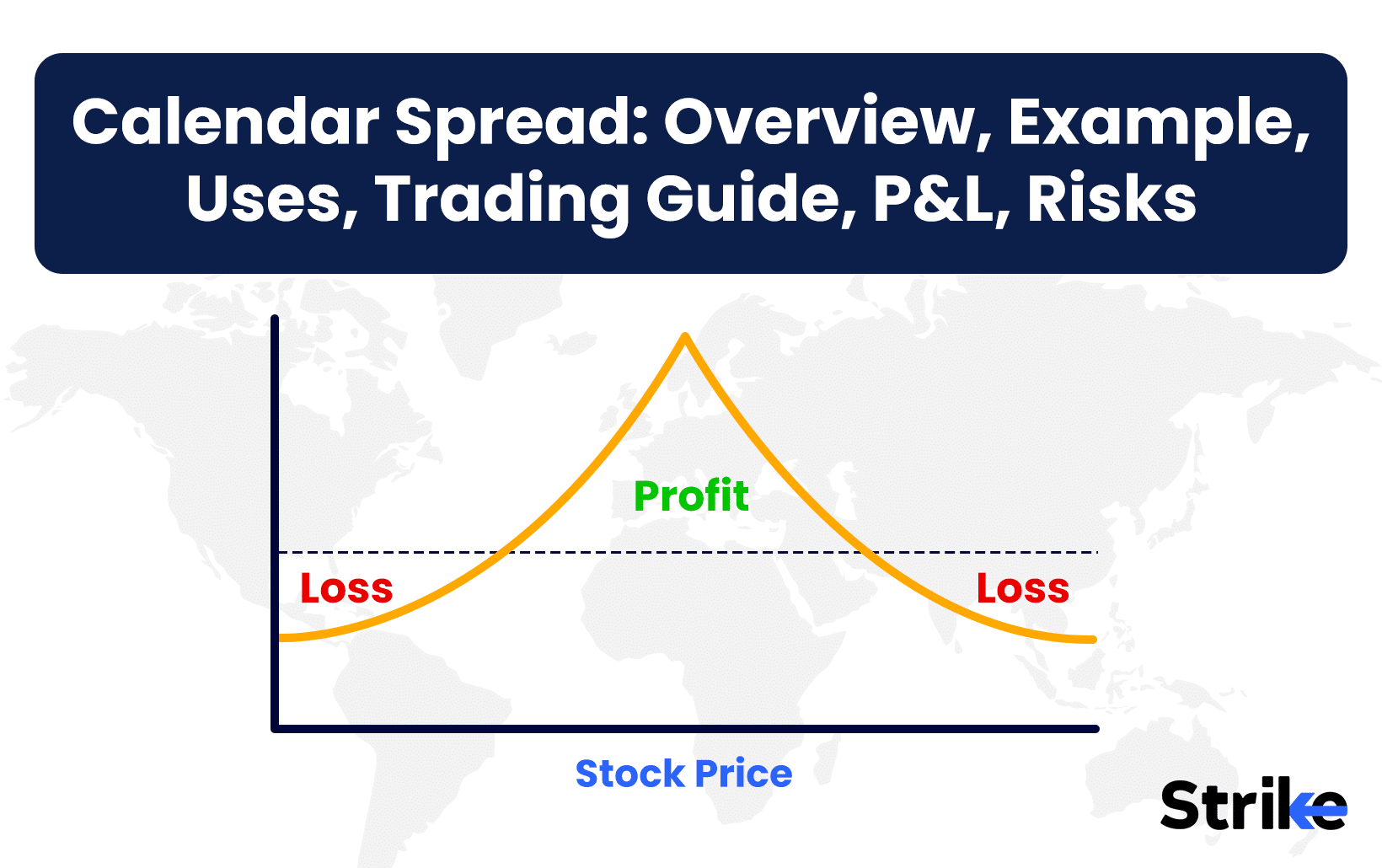
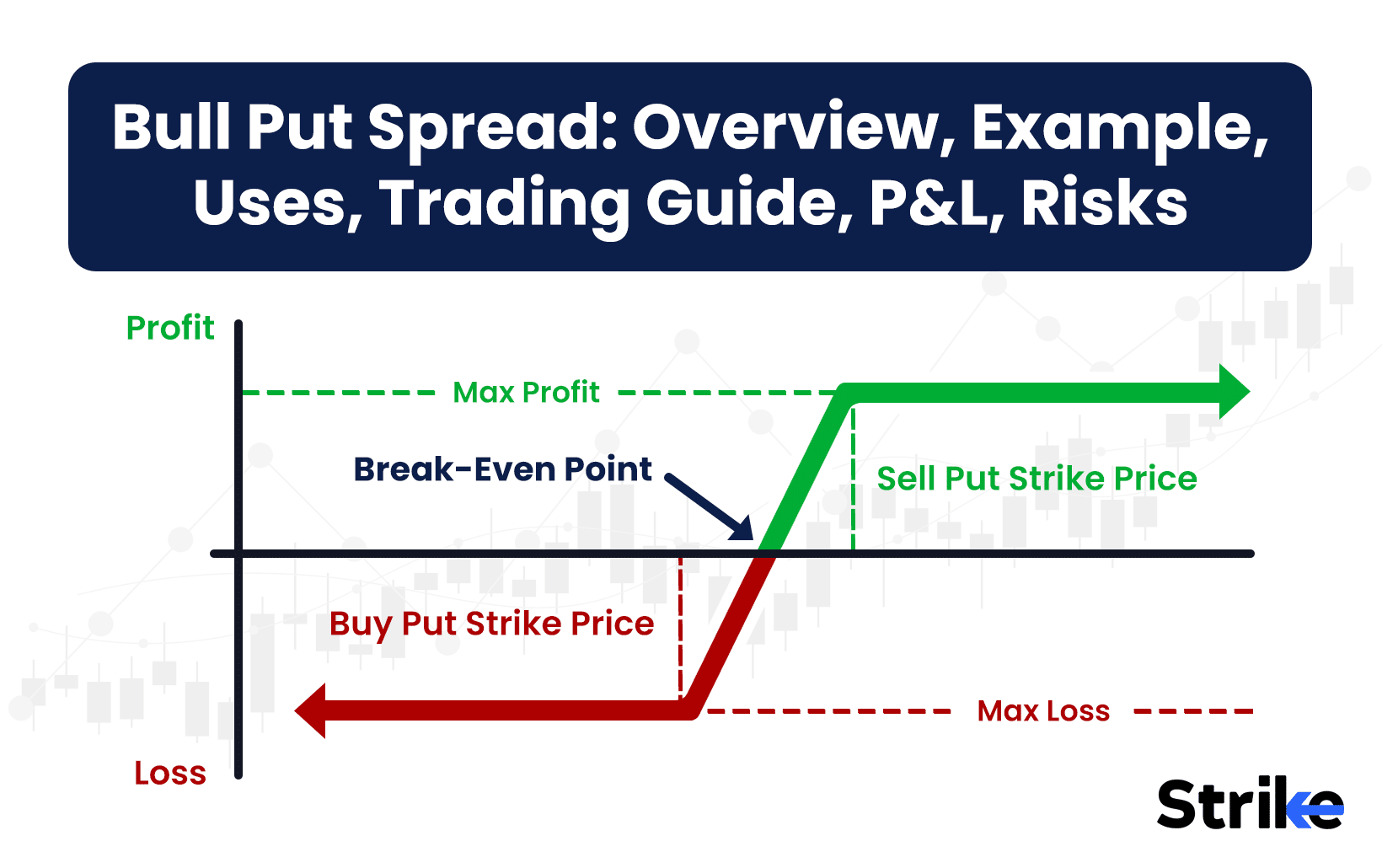





No Comments Yet